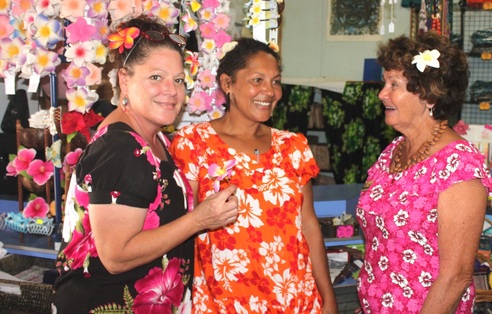
Advice from all quarters says if it is really windy don’t bother going to Thursday Island, said Tony. We were sitting at Punsand Bay and it was really windy, as it is most of winter when the east-south-east trade winds blow over the tip of Australia.
We wanted to go to see Doctor Jenny Wharton of Cairns, formerly Jenny Lewis of Toowomba. She was the niece of our travelling companions, Heather and Ross and had taken a 10-week posting to Thursday Island.
I had long been fascinated by Thursday since I was a child and read the Jon Cleary novel North From Thursday. It was more about New Guinea than Thursday Island but I still had a hankering to go to the Torres Strait Island.
We took a peek at the weather decided it would be lovely to visit Thursday on Thursday. They went off with Tony and booked for Wednesday (don’t ask me), then we found out that Dr Jenny was being helicoptered to another island for a clinic for Wednesay and Thursday. So we settled for Thursday on Friday.
The trade winds were kind. Fares cost about $130 for the day trip, or $56 concession. An hour’s trip from Seisia (pronounced Say-see-a) sailed us past Possession Island where Captain Cook stuck in the flag pole and declared all of Eastern Australia belonged to King George III, who went mad and lost the American colonies.
To the east of the tip of Australia is pretty Somerset Beach and the ruins of the first European settlement at the top of Cape York. Somerset was supposed to be the base for pilots to guide ships through the Torres Strait and inner Barrier Reef but white ants ate the buildings and big tides played havoc with the pilot boats.
Thursday Island was selected as the second site and today is the base for 50 pilots to guide about 2000 ships a year through the tricky waters. It was named Thursday because Captain Bligh, adrift in the long boat after the mutineers threw him off the Bounty, sailed past a nearby island on a Wednesday and named it Wednesday. Bligh missed Thursday and Friday a little to the south (it’s complicated).
Turquoise waters surround Thursday, although they were not quite as stunningly brilliant after I took off the Polaroids. The walk from the wharf to the town has pavement inscriptions in a time line of significant occasions in the island’s history. Some famous TI people were quoted. My favourite was this from Ephraim Bani, a Torres Strait chief who worked as a pearl diver and later studied linguistics and anthropology, becoming a leading force in TI cultural heritage: “The past must exist for the present to create the future.”
We caught up with the delightful Dr Jen at the hospital, had a quick tour and learnt she loved the place. She often cared for Torres Strait islanders when they were flown to Cairns hospital so she would return with a better understanding of their culture, homes and afflictions.
One of the challenges at the neat, modern hospital was trying to decide when to call in the helicopters. The doctors take calls from other islands and a few remote northern mainland settlements such as Bamaga and need to make a decision over the phone about whether a sick or injured person should be flown to Thursday. Helicopter evacuations are expensive. The doctors also need to decide when a patient at the Thursday hospital is serious enough to warrant an evacuation to Cairns.
After hundreds of kilometres of dust, challenging roads, crocodiles, ants, snakes, and new experiences such as spending a night in a gravel pit, chemist Heather almost bloomed in the spic and sterile rooms of the hospital. She confided in Dr Jen that she almost wept for joy when we finally reached Punsand Bay and she discovered a flushing toilet.
Mona’s is the hot souvenir spot in town. I indulged in a bit of whimsy and bought a fake frangipani to wear in my hair for lunch at the Torres Hotel. Flowers in the hair seemed to be the thing on Thursday. On the way back to the wharf I wandered back into Mona’s to chat with the fun staff Francine Zoia and Michelle Resek.
Michelle lives on Prince of Wales, the biggest island in Queensland with no power or water. The Reseks have 24 water tanks and solar power and the family embodies the cultural diversity of Torres Strait.
“We are really bloody mongrels,” grins Michelle. Her father was an Austrian who fled the Nazis and ended up in New Guinea. He married Michelle’s mother, who had a Papua New Guinea mother and US father. Michelle’s husband is descended from Japanese and Malaysian pearl divers; their children can also mix in Aboriginal and Torres Strait blood.
Mona’s girls tell me I am right on line with my fake frangipani. The reason why all the women are wearing flowers in their hair is because it’s Friday. On Thursday Friday is flower day. Yay!
PICTURE ABOVE: Michelle Resek (centre) with fellow Mona staffer Francine Zoia (right) and council worker Nola Ward Page. Friday is flower day on Thursday.
We wanted to go to see Doctor Jenny Wharton of Cairns, formerly Jenny Lewis of Toowomba. She was the niece of our travelling companions, Heather and Ross and had taken a 10-week posting to Thursday Island.
I had long been fascinated by Thursday since I was a child and read the Jon Cleary novel North From Thursday. It was more about New Guinea than Thursday Island but I still had a hankering to go to the Torres Strait Island.
We took a peek at the weather decided it would be lovely to visit Thursday on Thursday. They went off with Tony and booked for Wednesday (don’t ask me), then we found out that Dr Jenny was being helicoptered to another island for a clinic for Wednesay and Thursday. So we settled for Thursday on Friday.
The trade winds were kind. Fares cost about $130 for the day trip, or $56 concession. An hour’s trip from Seisia (pronounced Say-see-a) sailed us past Possession Island where Captain Cook stuck in the flag pole and declared all of Eastern Australia belonged to King George III, who went mad and lost the American colonies.
To the east of the tip of Australia is pretty Somerset Beach and the ruins of the first European settlement at the top of Cape York. Somerset was supposed to be the base for pilots to guide ships through the Torres Strait and inner Barrier Reef but white ants ate the buildings and big tides played havoc with the pilot boats.
Thursday Island was selected as the second site and today is the base for 50 pilots to guide about 2000 ships a year through the tricky waters. It was named Thursday because Captain Bligh, adrift in the long boat after the mutineers threw him off the Bounty, sailed past a nearby island on a Wednesday and named it Wednesday. Bligh missed Thursday and Friday a little to the south (it’s complicated).
Turquoise waters surround Thursday, although they were not quite as stunningly brilliant after I took off the Polaroids. The walk from the wharf to the town has pavement inscriptions in a time line of significant occasions in the island’s history. Some famous TI people were quoted. My favourite was this from Ephraim Bani, a Torres Strait chief who worked as a pearl diver and later studied linguistics and anthropology, becoming a leading force in TI cultural heritage: “The past must exist for the present to create the future.”
We caught up with the delightful Dr Jen at the hospital, had a quick tour and learnt she loved the place. She often cared for Torres Strait islanders when they were flown to Cairns hospital so she would return with a better understanding of their culture, homes and afflictions.
One of the challenges at the neat, modern hospital was trying to decide when to call in the helicopters. The doctors take calls from other islands and a few remote northern mainland settlements such as Bamaga and need to make a decision over the phone about whether a sick or injured person should be flown to Thursday. Helicopter evacuations are expensive. The doctors also need to decide when a patient at the Thursday hospital is serious enough to warrant an evacuation to Cairns.
After hundreds of kilometres of dust, challenging roads, crocodiles, ants, snakes, and new experiences such as spending a night in a gravel pit, chemist Heather almost bloomed in the spic and sterile rooms of the hospital. She confided in Dr Jen that she almost wept for joy when we finally reached Punsand Bay and she discovered a flushing toilet.
Mona’s is the hot souvenir spot in town. I indulged in a bit of whimsy and bought a fake frangipani to wear in my hair for lunch at the Torres Hotel. Flowers in the hair seemed to be the thing on Thursday. On the way back to the wharf I wandered back into Mona’s to chat with the fun staff Francine Zoia and Michelle Resek.
Michelle lives on Prince of Wales, the biggest island in Queensland with no power or water. The Reseks have 24 water tanks and solar power and the family embodies the cultural diversity of Torres Strait.
“We are really bloody mongrels,” grins Michelle. Her father was an Austrian who fled the Nazis and ended up in New Guinea. He married Michelle’s mother, who had a Papua New Guinea mother and US father. Michelle’s husband is descended from Japanese and Malaysian pearl divers; their children can also mix in Aboriginal and Torres Strait blood.
Mona’s girls tell me I am right on line with my fake frangipani. The reason why all the women are wearing flowers in their hair is because it’s Friday. On Thursday Friday is flower day. Yay!
PICTURE ABOVE: Michelle Resek (centre) with fellow Mona staffer Francine Zoia (right) and council worker Nola Ward Page. Friday is flower day on Thursday.
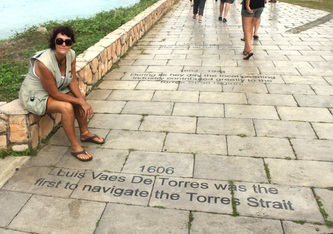
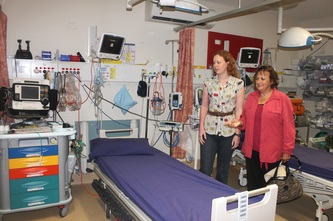
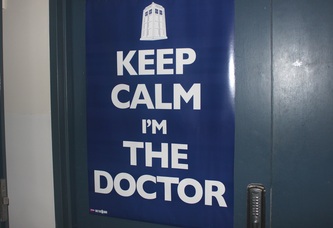
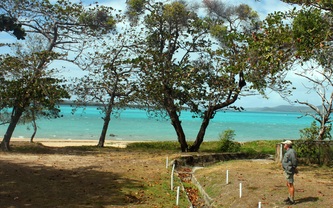
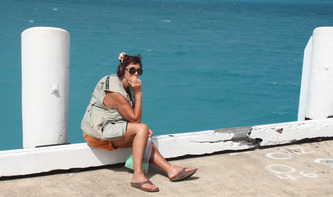
 RSS Feed
RSS Feed
